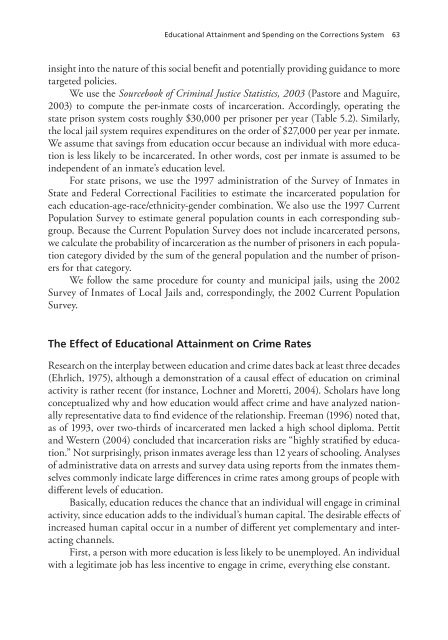The Benefits to Taxpayers from Increases in Students - RAND ...
The Benefits to Taxpayers from Increases in Students - RAND ...
The Benefits to Taxpayers from Increases in Students - RAND ...
You also want an ePaper? Increase the reach of your titles
YUMPU automatically turns print PDFs into web optimized ePapers that Google loves.
Educational Atta<strong>in</strong>ment and Spend<strong>in</strong>g on the Corrections System 63<br />
<strong>in</strong>sight <strong>in</strong><strong>to</strong> the nature of this social benefit and potentially provid<strong>in</strong>g guidance <strong>to</strong> more<br />
targeted policies.<br />
We use the Sourcebook of Crim<strong>in</strong>al Justice Statistics, 2003 (Pas<strong>to</strong>re and Maguire,<br />
2003) <strong>to</strong> compute the per-<strong>in</strong>mate costs of <strong>in</strong>carceration. Accord<strong>in</strong>gly, operat<strong>in</strong>g the<br />
state prison system costs roughly $30,000 per prisoner per year (Table 5.2). Similarly,<br />
the local jail system requires expenditures on the order of $27,000 per year per <strong>in</strong>mate.<br />
We assume that sav<strong>in</strong>gs <strong>from</strong> education occur because an <strong>in</strong>dividual with more education<br />
is less likely <strong>to</strong> be <strong>in</strong>carcerated. In other words, cost per <strong>in</strong>mate is assumed <strong>to</strong> be<br />
<strong>in</strong>dependent of an <strong>in</strong>mate’s education level.<br />
For state prisons, we use the 1997 adm<strong>in</strong>istration of the Survey of Inmates <strong>in</strong><br />
State and Federal Correctional Facilities <strong>to</strong> estimate the <strong>in</strong>carcerated population for<br />
each education-age-race/ethnicity-gender comb<strong>in</strong>ation. We also use the 1997 Current<br />
Population Survey <strong>to</strong> estimate general population counts <strong>in</strong> each correspond<strong>in</strong>g subgroup.<br />
Because the Current Population Survey does not <strong>in</strong>clude <strong>in</strong>carcerated persons,<br />
we calculate the probability of <strong>in</strong>carceration as the number of prisoners <strong>in</strong> each population<br />
category divided by the sum of the general population and the number of prisoners<br />
for that category.<br />
We follow the same procedure for county and municipal jails, us<strong>in</strong>g the 2002<br />
Survey of Inmates of Local Jails and, correspond<strong>in</strong>gly, the 2002 Current Population<br />
Survey.<br />
<strong>The</strong> Effect of Educational Atta<strong>in</strong>ment on Crime Rates<br />
Research on the <strong>in</strong>terplay between education and crime dates back at least three decades<br />
(Ehrlich, 1975), although a demonstration of a causal effect of education on crim<strong>in</strong>al<br />
activity is rather recent (for <strong>in</strong>stance, Lochner and Moretti, 2004). Scholars have long<br />
conceptualized why and how education would affect crime and have analyzed nationally<br />
representative data <strong>to</strong> f<strong>in</strong>d evidence of the relationship. Freeman (1996) noted that,<br />
as of 1993, over two-thirds of <strong>in</strong>carcerated men lacked a high school diploma. Pettit<br />
and Western (2004) concluded that <strong>in</strong>carceration risks are “highly stratified by education.”<br />
Not surpris<strong>in</strong>gly, prison <strong>in</strong>mates average less than 12 years of school<strong>in</strong>g. Analyses<br />
of adm<strong>in</strong>istrative data on arrests and survey data us<strong>in</strong>g reports <strong>from</strong> the <strong>in</strong>mates themselves<br />
commonly <strong>in</strong>dicate large differences <strong>in</strong> crime rates among groups of people with<br />
different levels of education.<br />
Basically, education reduces the chance that an <strong>in</strong>dividual will engage <strong>in</strong> crim<strong>in</strong>al<br />
activity, s<strong>in</strong>ce education adds <strong>to</strong> the <strong>in</strong>dividual’s human capital. <strong>The</strong> desirable effects of<br />
<strong>in</strong>creased human capital occur <strong>in</strong> a number of different yet complementary and <strong>in</strong>teract<strong>in</strong>g<br />
channels.<br />
First, a person with more education is less likely <strong>to</strong> be unemployed. An <strong>in</strong>dividual<br />
with a legitimate job has less <strong>in</strong>centive <strong>to</strong> engage <strong>in</strong> crime, everyth<strong>in</strong>g else constant.
















